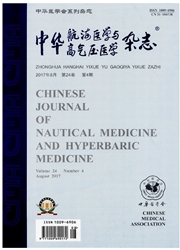

 中文摘要:
中文摘要:
目的 探讨改进应急救护系统用于暴风雨灾害临床急救的效果.方法 以海口市暴风雨应急救护的患者400例作为研究对象,分为对照组和实验组,每组200例,对发生暴风雨灾害时的患者一般情况、医院的临床急救反应时间、患者的生存状况以及患者对应急救护系统的满意度等系列指标进行回顾性比较分析.结果 应急救护系统前后,临床对于暴风雨灾害临床急救效果存在明显的差别.对照组临床急救反应时间17~75 min,平均(37.3 ±13.1)min;实验组6~ 49 min,平均(19.8 ±6.9) min,2组差异有统计学意义(P<0.05).实验组病死率1.5%,明显低于对照组5.0%(P<0.05).实验组患者对于临床应急救护的满意率95.5%,明显高于对照组患者满意率83.5%(P<0.05).结论 改进应急救护系统使台风灾害时的临床应急准备、灾前预防、灾后救援、灾情检测效果有明显提高.这一改进可以对受暴风雨灾害的患者提供及时、准确、有效的救护,有利于患者的救治和恢复.
 英文摘要:
英文摘要:
Objective To investigate the efficiency of the improved emergency care system in urgent medical aid of casualties occurred during hurricane disasters.Methods Four hundred patients who received urgent medical care during hurricane disasters were used as our research subjects, and they were randomly divided into the control and experimental groups.Retrospective survey and analysis were made on the general conditions of the casualties at the time of the hurricane disaster relief, urgent medical response time, the surviving conditions of the casualties and satisfaction to the application of the improved emergency care system.Results Significant differences could be noted in the clinical effects of urgent medical care during hurricane disaster relief, when comparisons were made with or without the application of the improved emergency care system.Urgent medical response time of the control group was 17 to 75 minutes, averaging (37.3 ± 13.13) minutes, while that of the experimental group was 6 to 49 minutes, averaging (19.8 ± 6.9) minutes.Significant statistics could be found, when comparisons were made between them(P 〈 0.05).The mortality rate of the experimental group was 1.5%, which was significantly lower than 5.0% of the control group (P 〈0.05).The satisfaction rate on the part of the patients in the experimental group was 95.5%, which was significantly higher than 83.5% of the control group(P 〈 0.05).Conclusions The improved emergency care system could significantly improve clinical emergency preparedness, pre-disaster prevention, disaster relief, as well as disaster predication.The improved system could enable medical facilities to provide in-time, accurate and effective medical care to the victims during hurricane disasters, and was obviously beneficial to the medical aid and recovery of casualties.
 同期刊论文项目
同期刊论文项目
 同项目期刊论文
同项目期刊论文
 期刊信息
期刊信息
